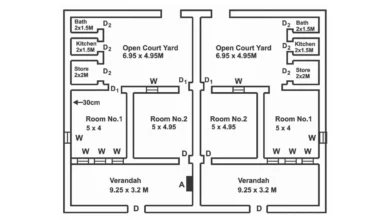Factors Affecting Material Costs
Table of Contents
Factors Affecting Material Cost
The following factors affect material costs;
Quality of Material
Material cost changes with the quality of the material. If the material of fine quality is used, material costs will increase, and if an ordinary quality material is used, then material costs will reduce.
Ups & Down or Variation in Prices
As a result of fluctuation in the demand of materials in the market, often variations also occur in the prices of materials, due to which material cost is also affected.
Distance From Market to Project
Material cost can also be influenced due to the distance of the market supplying electrical accessories, tools, and equipment, from the project site. For example, if the distance of the project from the market is large (i.e., a project is located at such a place, where no nearby electrical items market is available) then arrangements will have to be made to supply material for the project site from a remote area. Under such a situation, material costs will increase due to the inclusion of transport charges in the material costs.
Change in Specifications of Material
Sometimes, changes in the specifications of materials during the operation of a project become necessary, as a result of which material costs may be affected. For example, if a 1” conduit has to be used instead of ¾” PVC conduit, if a 56” ceiling fan has to be used instead of a 48” ceiling fan, or if a 7/.029” cable has to be used instead of a 3/.029” cable, material costs will definitely be affected due to changes in the material specifications.
Changes in Design
Sometimes, slight modifications or amendment is carried out during the continuation of project work for saving time and introducing certain extra facilities for the satisfaction of a designer or an engineer. As a result of this modification in design, material costs are also often affected.
Factors Affecting Transport Cost
The transport cost is affected as a result of the following factors;
Location of Project
The supply of material, as well as labor to any project, is possible only through transport, and if a project is located at some distant place, transport cost for the delivery of equipment or material, etc., to the project site will greatly be affected. For example, if the installation of a high transmission line (H.T.L) is going to take place in some remote area outside the city, then transport costs for the supply of corresponding equipment e.g., towers, electrical wires, insulators, sand, crushed stone, cement, etc., will be high. Inversely, if a project is located nearby the city or essential tools or equipment are easily available nearby the project site, transport costs will obviously be small.
Type of Project
Transport costs also depend on the type of project. Because transport costs for residential projects will be different than those for commercial and industrial projects. Similarly, transport costs for the installation of a high voltage line will be low, whereas transport costs for the accomplishment of sub-stations and powerhouses, etc., will be high. This is because, for the completion of huge projects like substations as well as powerhouses, etc., apart from ordinary transport, most often a temporary railway track is also provided from a nearby railway station so that heavy material and heavy machinery can be supplied to the project site. Thus, transportation costs of such projects increase further. In the case of a power station, most often a temporary track is converted to a permanent track so that when the power station starts operating, fuel (coal, diesel, petrol, etc.) could be supplied to it through this track.
Availability of Transport
By the availability of transport, we mean transport facility up to the project site. That’s whether a transport facility is always available to the project site or not. If the facility of a public transport for the transportation of labor or other equipment or material etc., is available then a substantial reduction in the transport costs can be witnessed. Otherwise, special arrangements have to be made for transportation, which causes an increase in the transport costs.
Quantity of Material
The quantity of material also affects transport costs. For transportation of material in small quantities, transport costs will be the same as for transportation in large quantities. Sometimes, transport costs even become low as a result of transportation of large quantities of material.
Necessary Steps for Preparing a Cost Estimate
The following steps have to be taken into consideration for estimating the costs of any installation or project;
Layout of Building
For estimation purposes, the availability of a layout of the proposed building is very necessary, because, without a layout, it becomes absolutely impossible to prepare an estimate of the building. A wiring layout is prepared based on a building’s layout, moreover, switchgear (appliances used for controlling, regulating, and securing electricity, are called switchgear; e.g., fuses and breakers, etc.) and distribution fuse boards spots also reflected through a building’s layout. Therefore, measurement of batten or conduits as well as cables can also be done through building layouts.
Type of Wiring
It is also necessary to know about the type of wiring which is going to be installed in a building for estimating purposes, or what type of wiring has to be installed in the building. The object behind learning about the type of wiring to be adopted is to have an accurate estimate of the electrical appliances to be used according to this type of wiring.
List of Material
After understanding the type of wiring, it is also necessary to know about the total number of wiring points (i.e., switches, sockets, lamps, fans, tube lights, etc.). For this purpose, a list of materials is prepared, so that total costs could be estimated.
Material Costs
Material costs actually depend on the project location. If the project is located at a place, where the material required for the project cannot be availed from the nearby surrounding areas, for this purpose an arrangement must be made for the supply of material from some far-off place. Thus, material costs increase with a risk of slow work progress. Thus, for reducing material costs material required for any project must be easily available.
Labor Costs
Labor costs also occupy an important place to determine an estimate of the cost of any installation or project. Labor costs depend on the following factors;
(i). Type of Projects
(ii). Working Conditions
(iii). The Labor Market
Above mentioned points have already been explained in the previous pages.
Transport Costs
Transport costs are also essentially included in estimating the cost of any project because the delivery of material to the project site can be possible only through transport. For example, if an electric line is desired to be installed, then transport is essentially required for the supply of related instruments or equipment (i.e., towers, poles, electricity wires, insulators, sand, crush, etc.) to the project site. In the case of availability of equipment nearby the project location, transport cost tends to be small, and in a situation of its availability in some far-off place, transport costs increase. There are some projects (e.g., powerhouse, etc.) for which a permanent railway track is constructed from a nearby railway station to the project site for a making a permanent supply of heavy machinery and fuel for the project site. The transportation costs of such projects are obviously quite high.
Contingencies
By contingencies, we mean such superfluous costs, which have to be tolerated as a result of a delay in the completion of any project or which have to be borne as a result of certain emergencies or accidents, etc. These contingency costs are compulsorily included in the total cost equal to 3 to 5 percent of the material cost or labor cost. The extra costs which have to be borne as a result of an increase in material cost or labor rates, are also included under this head.
Over Head Charges
Overhead charges or standing charges are types of additional costs being incurred on any project or business, which tend to be necessary for the continuation of that project, however, which are not received in any contract e.g., salaries, rent, government taxes, lighting, water, increase in the cost of material, project or business advertisement, insurance, stationery, postage charges, and general travel expenses, etc. As these costs are incurred on small or large projects, therefore such costs are also taken into consideration while doing cost estimation. Overhead charges are enforced as a percentage of the actual prices of all the items. Normally, overhead charges tend to be 10 to 15 percent of the total estimated cost of labor and material.
Supervision Charges
Every contract practically comes to an accomplishment under the supervision of skilled and trained engineers, who keep presenting their expert opinion about different aspects of the project. The charges or remuneration, which are paid to these teams of experts for their services, are known as supervision charges. Supervision charges tend to be 1 to 1.5 percent of the total costs.
Profit
At the time of preparing an estimate of any project, it is necessary to include an acceptable and specific rate of profit in the project estimate in the shape of a percentage (normally from 10 to 30 percent). However, this rate of profit depends on a contractor’s will, the decision of which is made by a contractor keeping in view the following factors;
(i). Size of Job
(ii). Nature of work
(iii). Quantity of Work
(iv). Degree of Competition
(v). Duration to Complete the Work
Remember that percentage profit can decrease substantially as a result of defective planning, unsuitable and less knowledgeable staff, purchase of inferior quality material, a lack of proper supervision, etc.
Next Topic: Importance of Tables Used in Planning & Estimating
Previous Topic: labor costs, material costs, and transport costs Estimating
For electronics and programming-related projects visit my YouTube channel.





